It is necessary to regularly review the ‘state of play’ regarding key elements of the earth mysteries spectrum, and here we take a look at leys. This simple concept has been taken down so many speculative paths that it is sometimes hard to see the core of the concept. NE editors John Billingsley and Mike Haigh dispassionately assess the current status of the various hypotheses that have arisen over the years.
Throughout the history of earth mysteries and its associated spin-offs there has run a single thread, albeit one that has become curiously and perhaps irremediably tangled; that thread is the ley, also known – tautologously – as a ley line. E.m. veterans will remember that when they entered the world of alternative archaeology, the word ‘ley’ was quite clearly understood – it was an apparently deliberate alignment of certain kinds of historical sites, detectable on the ground and through maps. The term had been coined by Alfred Watkins in the 1920s, who was the first to consolidate the insights of various antiquarian scholars, especially W H Black (1820-1870), that a practice of intentional alignment had existed in the prehistoric world.
It was hard for his contemporary archaeologists, schooled in the conventional view of the past as an unsophisticated struggle to develop, to come to terms with the implications of such insights, and the idea, though found attractive and worthy of further investigation by many outside academia, was soundly ridiculed in official circles in Britain. Similar research was taking place in Germany in the interwar years, but was warmly backed by the new Nazi state. The natural backlash in Britain against Nazi ideology drove ley research, amongst other things in which it had dabbled, into the shadows after the Second World War, and it was not to re-emerge until the 1960s. It was Philip Heselton, the first editor of both The Ley Hunter and Northern Earth Mysteries, who decided to revive The Straight Track Club, and that first exploratory gesture into understanding the more mysterious implications of the landscape was to broaden into the approach we now know as earth mysteries.
John Michell, with the publication of his seminal revision of prehistoric capabilities, The View Over Atlantis, in 1969, dragged leys back into popular consciousness, as a visionary experience of the landscape. All contemporary e.m. really dates from this book, and many of the twists and turns of the fundamentally dead straight line that Watkins had called the ley developed in the following decades.
Here, we review the state of play of some of the notions that, over the last eighty years, have been thrown at Watkins’ original insight.
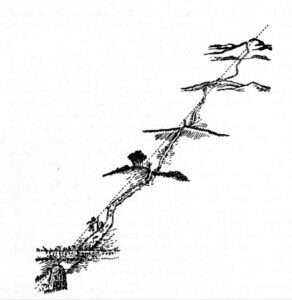
THE WATKINS LEY
The Watkins ley is the basic root of all ley-hunting, and is simply four or preferably more sites apparently deliberately and accurately aligned. The primary kinds of site seen as significant in detecting alignments were prehistoric stones, circles, barrows and earthworks, prominent hill-tops, castles and pre-Reformation churches and cathedrals; secondary sites were holy wells, moats and ponds and a certain range of place-names.
Alfred Watkins was a practical man, and when he found that he had enough evidence for alignments for him to start constructing a hypothesis, he asked the reasonable question ‘what were they for?’ His best guess (not entirely a guess, as fragments of trackway were found buried along some of his leys) was that the alignments were the remains of old roads – hence the title of his major work, The Old Straight Track, still required reading for anybody who presumes to know about leys.
OCCULT LINES OF THOUGHT
The markpoints by which Watkins found his leys, however mundane his interpretation, were evidently connected with ritual sites, from stone circles to churches. He was aware of this, and the point was quickly appreciated by occultists. Dion Fortune and others wrote of shimmering lines of magical energy which would appear to the seek- er under appropriate conditions and could be used for magical work. It was these associations that directly led, thirty to forty years later, to the idea of leys as lines of energy.
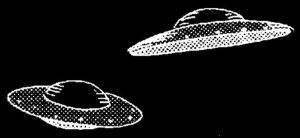
ORTHOTENIES
The 1950s was the enthusiastic first decade of what we now know as ufology, and it was during this time that attempts were made to associate ufo sightings with alignments. The idea of leys as trackways reached for the skies with Aimé Michel’s suggestion that ufo sightings seemed to follow straight lines roughly commensurate with the terrestrial lines; he called these aerial alignments orthotenies. It was even suggested that ufos in some way picked up energy from leys. Tony Wedd took the ufo-ley association even further with his booklet Skyways and Markpoints, but the idea was not particularly helpful and the term is nowadays never heard. What orthotenies did do, however, in a way that influenced later thinking, was reinforce the incipient notion of leys as carriers of some unknown mysterious energy, and the idea that alignments may be connected with otherworldly travel.
SCEMB LINES
One of the main criticisms of Watkins’ hypothesis is that the range of candidate sites involves too wide a spread of history – a line consisting of sites as chronologically separate as a neolithic chambered tomb and a mediaeval parish church does not indicate deliberate alignment. Watkins’ claim that many churches were built on existing sacred sites cannot be adequately demonstrated, although there is always a certain chance that this is the case; after all, the places where we choose to live today tend to be much the same as those founded by the first farmsteads.
Some researchers have therefore limited their ley-hunting to sites within a narrower time-frame. Traditional dowser, Bill Williams, working in North Wales, pointed out that limiting sites to megaliths and earthworks – Stones, Circles, Earthworks, Mounds and Barrows, hence SCEMB – still turned up convincing alignments in areas where such sites survived, and the point was strongly affirmed by John Michell, who only used such sites in tracing alignments in Penwith, Cornwall.
ENERGY LEYS
The idea that the alignments of ancient sites held some kind of mystical power took root in esoteric circles soon after Watkins’ insight, and received reinforcement in The View Over Atlantis, but it was in the early 1970s that the idea really blossomed, as people began to realise that the concept of trackways did not sufficiently explain leys and their associated phenomena.
For a while ‘energy’ became the over-riding thesis in alternative archaeology, and various items of experimental gadgetry were brought in to supplement the reports of dowsers such as Tom Graves and investigate the possibility of leys and ancient sites holding or channelling some form of energy, known or otherwise. It was hoped that such effects might explain the motivation for leys – i.e. that they were following telluric currents – as well as anomalies like the apparent clustering of apparently supernatural events, such as fairies, ghosts and light phenomena, around leys and their sites. The enthusiasm gave rise to the Dragon Project, an extensive experimental programme organised by The Ley Hunter and incorporating investigative methods from magnetometers to meditators, in an attempt to validate the existence of unusual energy effects at and between ancient sites; most of the work took place at the Rollright Stones. Overall, however, the project, after hundreds of hours’ work from a large team, found no evidence of an unknown energy and no reliable indication of energy anomalies. When experimental results do not support a hypothesis, the hypothesis is set aside and focus shifts to another model. Leys, it seemed, are not lines of demonstrable energy, known or otherwise. The years of the Dragon Project were not wasted, however – they demonstrated what Watkins had warned of, that some avenues of ley enquiry might turn out to be a mare’s nest.
Current thinking in core earth mysteries notes that the 1970s was a time of global anxiety over the ‘energy crisis’, an obsession which fed into research priorities in the same way that contemporary social concerns incite focussed research in other fields. It was also a time of enthusiasm over the ‘electronic revolution’, which influenced the way the ‘ley network’ was seen – the relationship between energy-line grids and printed circuit boards may not have been superficial.
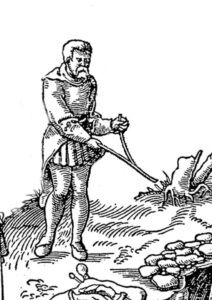
DOWSERS’ ENERGY LINES
The role of dowsing in ley-hunting has been fiercely contested. Though most of those in earth mysteries have had experience of dowsing, and do not doubt its application in other areas, such as finding water, minerals, even lost objects and people, or illuminating personal issues within our subconscious, its effectiveness in ley-hunting has been called into question. It is notable that traditional dowsers did not seem to discover straight lines of energy until the concept of energy ley lines emerged in the 1970s.
There are reasons for this uncertainty. Dowsers’ findings frequently do not agree with each other. Where one is trying to establish the validity of leys, to have conflicting data like this does not support one’s case. Another reason derives from dowsing’s known characteristic of requiring a clear conception of what it is one is looking for. Water, a person, or a gold ring – these can be clearly conceived. But what is one looking for when one is ley-hunting?
If a ley is a line of sites on the ground, then as long as the sites are still there, the ley should be visible and we have no need of dowsing. If the sites are not there, then there is a dilemma – we have no particular reason to look there, for one thing; after all, if we dig for treasure, we don’t just dig anywhere. So dowsing for leys presupposes a kind of remanence that dowsing, if not the eyes, can pick up on and even enhance. Perhaps that may be a remanence in the sense that it is possible to dowse the past locations of standing stones, etc, and the skill is used by some archaeologists and utilities surveyors.
A more popular hypothesis within dowsers, however, is that leys are lines of energy, and don’t need sites to back them up – i.e. that the lines are primary and the aligned sites on them secondary. This, it must be said, is a considerable departure from Watkins’ original conception and from the archaeological evidence for deliberate alignment that has emerged from the efforts of ‘alternative archaeology’.
Yet, as we have seen, the idea of energy lines has been attractive within and without core earth mysteries, even though core e.m. has found the hypothesis broadly untenable in its basic notion, because experiments have been unable to establish the presence of a measurable energy. We may be subjectively aware of some atmosphere, or what some call subtle energy, at sites, but what is that energy? It doesn’t respond to equipment measuring known energy forces, so it cannot be identified or objectively recorded. If it cannot be identified, then it is difficult to conceptualise it sufficiently for dowsing to give reliable and repeatable results – the idea of ‘energy’ is just too fuzzy, taking in notions as diverse as electricity, vitality and atmosphere. If it is hard to find two people who agree about what they mean by energy, then it is hard to expect dowsing to yield reliable results in this particular area.
Nonetheless, many dowsers, searching for ‘energy’, claim to find a multiplicity of so-called ‘ley lines’ across the landscape. Few of these lines seem to have any association with the alignment of sites that constitutes a ley, nor with any historical appreciation of the land. These dowsers are picking up on something, and it would be good to find out exactly what; however, it does not help understanding to call it by a name that has already been applied to something else rather different.
Hence, in core earth mysteries, leys claimed through dowsing are not seriously considered unless backed up by solid empirical evidence of alignment on the ground. Dowsing, in the earth mysteries context, offers better opportunity for insight when applied to the particular properties of a site, such as a standing stone, or when looking for remanence of past structures; or for developing a personal understanding of and attunement to place.
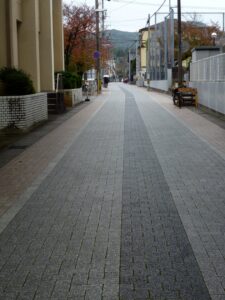
SPIRIT PATHS
After various attempts to prove that leys transmitted some kind of power had come to nothing, researchers decided to look elsewhere for an explanation. It was obvious that Watkins’ original theory that they were trade routes was untenable. They cut across swamps and went over cliffs. Only ghosts could make such journeys! Although an explanation for leys was still eluding researchers, the business of gathering information about them was continuing. The pages of The Ley Hunter filled with stray facts and odd findings. Rather than a fruitless search for meaning, researchers began to look for evidence for leys in new places. As they did so, a new explanation for the phenomenon emerged.
One source was the archaeological record. Academics had long rejected the idea of alignments of multi-period sites, but there was ample evidence for long, straight sites, such as the cursus. They are also often associated with a type of ancient mound known as a long barrow, which resemble long straight ridges of earth.
Elsewhere in the world, new forms of aligned sites were being investigated. In Peru, the Incas had built long straight roads to hold their emEARTH MYSTERIESpire together. On the Pampas around Nazca, a system of long straight lines stretch across the desert. In SW USA, an extended system of straight tracks was noted around Chaco canyon.
It was in mainland Europe that some of the most interesting work was being done. In Holland, John Palmer began to investigate a series of long straight mediaeval roads leading to cemeteries. These were known as doodwegen (death roads), iykwegen (corpse roads) or spokenwegen (ghost roads). A common theme began to emerge, linking many of these linear features – a clear link with ancestors and the spirits of the dead. From the prehistoric burial mounds linked to cursus monuments to the medieval ghost roads, straight features seem to be consistently bound up with the movement of spirits. Once this link was noticed, the race was on to spot other linear features and see if similar links could be established, and evidence piled up.
There seems to be a consistent link, going beyond time and culture, between linear features and ‘spirit entities’, however culturally conceptualised; that early societies associated spirit travel – whether in trance states or after death – with straight lines. The implication was that physical alignments manifested the belief in etheric spirit travel, in effect spiritualising the landscape.
Paul Devereux, investigating the effects and ritual use of psychotropic narcotics , extended the connection to trance states and the imagery experienced in such states of consciousness, such as long straight tunnels. Thereby was established a common denominator behind the widely spaced indicators of alignments, and Devereux moved towards a new hypothesis of leys as spirit paths, traversed by such as shamans, the dead, otherworldly beings and other beings outside our spatial reality. At present, this is the dominant hypothesis for alignments in core earth mysteries.
The advantage of this approach is that it retains the esoteric aspect of alignments that all researchers, even the pragmatic Watkins, have noted and acknowledges the spiritual and ritual role of landscapes, while drawing upon sound empirical evidence from other areas of research. As such, it is a good example of the way earth mysteries research incorporates both left and right-brain modes of enquiry. [MH]
LONG-DISTANCE ALIGNMENTS
The idea of alignments stretching over long distances has been around for a long time, but is highly questionable simply because one normally finds alignments on flat two-dimensional maps – whereas the land is a globe. The two are not equivalent, and when a straight line on the map is transferred to a curved surface, it deviates further from the straight the longer it gets. The well-known St. Michael’s Line from Cornwall to East Anglia is a case in point – it cannot be an alignment, and therefore cannot be a ley, because the extremities of the mapped line deviate considerably from an alignment on the ground.
A suggestion has been made, however, for so-called ‘corridors of significance’. These are broad strips within which significant sites appear to cluster, and the St. Michael Line may fall into this category. Statistically, though, such corridors are easily challenged. This does not invalidate the idea that sites may have been deliberately positioned within reach of some perceived alignment, but this would be resistant to proof.
Other long-distance lines are represented by the worldwide grid systems that have been claimed. The workable sizes of maps needed to plot these grids make any notion of accuracy woolly to say the least, but then the idea behind them has more to do with Buckminster Fuller and post-Gaian thinking than archaeology. Other than dowsing it is, to say the least, hard to find any evidence in any field of enquiry to support such grids, and they are not taken seriously in core earth mysteries.
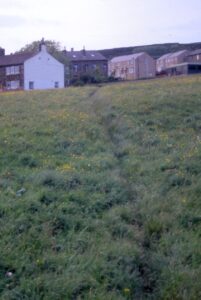
DESIRE PATHS
This is the newest interpretation of alignments, put forward by John Billingsley in NE99. Desire paths are known to planners everywhere as the informal paths created by people choosing the most direct route to their destination, rather than the one preferred by planners – hence the scuffed track that runs diagonally across the village green, for example. It is strongly linked with the Watkinsian ley, in that it suggests alignments came about as a natural inclination to head straight for prominent markpoints as an aid to navigation, especially in a trackless landscape (which doesn’t necessarily mean people will travel in a dead straight line). Overtime, travel will build up a network of trackways, some of which, ‘pilgrimage’ routes to sacred places, will become imbued with spiritual resonance.
NODAL POINTS
The ‘desire path’ implies a multiplicity of routes, since travellers will be coming from a multiplicity of directions. Research by Gordon Harris has suggested that the vestigial remains of such multiple tracks can still be traced, and that they converge on certain key ‘nodal points’, such as, for instance, Arbor Low stone circle. His meticulous maps, which can be bewildering in the density of such radial lines manifesting in fragments of trackway in the modern landscape, suggest that such nodal points, not the lines, are the key to the whole network.
TOWARDS SYNTHESIS
This last point perhaps suggests that ley research might be like ‘the finger and the moon’ adage – students who take the teacher too literally will pay too much attention to their teacher’s finger, and overlook the moon at which the finger is pointing. Perhaps we spend too much time on the nature of the ley and our own beliefs about the world and not enough on the nature of the place to which the ley can lead us. After all, when we go travelling, it is the destination that draws us, not the motorway.
But it is the line that has been the focus of debate, and there has been considerable heat generated between proponents of the energy ley and the spirit path. The two hypotheses are sometimes portrayed as mutually exclusive, but are they really so far apart? There is a possibility of convergence if one removes the energy ley from the dreamy notion of some unknown and unproven ‘earth energy’, and if one enhances the occult and esoteric properties of the spirit line. Occultists in general have long declared the power of the trained esoteric mind to leave a mark on the subtle landscape – this is what lies behind the belief in things like the Pharaoh’s Curse. If alignments were conceived of and used as lines for spiritual or shamanic travel, with markers on the ground affirming a physical dimension to the spiritual concept, then at the esoteric level we might expect to find a remanence of that conceptualisation – in other words, a kind of what we would today call ‘energy’. Convergence between the two camps may require little more than a shift in preconceptions.
SUMMARY
The history of ley-hunting is thus, like that of any other enquiry, one of dead-ends and reflected social concerns. It should be stated that the ley has not, in any of its interpretations, been proven. There has been enough evidence for alignment for investigation to reveal definite instances of deliberate alignment in prehistoric and later peoples, including archaeo-astronomical alignment, ritual or processional alignments, routeways, and spatial reference points. But these are not leys, they are alignments. Many in core earth mysteries now avoid the word ‘ley’, partly because no clear and shared idea exists of what we are talking about!
People coming from a landscape-based interpretation of leys, and those who think a ley is an energy line primarily identified by dowsing today find they have little in common, and are using the same word for two consider ably different things. The situation has reached a point where there sometimes seems little point in using the word ‘ley’. We may call a board with four legs a table, as indeed someone did at some originating point in the past; but then the more things that get piled on top of the table, the less it looks like a table. In the end the table breaks, and falls apart – and we no longer have a table.
Careless and self-referential use of the term has obscured the agreed meaning of the word ‘ley’, and it is probably too late to ‘return to basics’, as the babel is complete. Nonetheless, when we use the word ‘ley’ today, we should bear in mind Watkins’ original definition, and use that as a benchmark of meaning. We should – but whether it is still possible is in doubt.
FURTHER READING
The best general round-up of leys and alignments in general remains Paul Devereux and Nigel Pennick, Lines on the Landscape (Hale, 1989), though it lacks more recent research. Try also Philip Heselton, Ley Lines (Hodder & Stoughton, 1999) or Danny Sullivan, Ley Lines (Piatkus, 1999). Much of the post-2000 work is negatively affected, I feel, by under-researched and populist assumptions about ‘energies’ and ‘energy dowsing’ which do not address phenomenological understandings.
For leys, Alfred Watkins’ The Old Straight Track is the starting point; John Michell’s The View Over Atlantis (Garnstone Press, 1969 & 1972) set the scene for the rediscovery of leys and related topics. On the place of leys within earth mysteries, see Philip Heselton, Earth Mysteries (Element, 1995), Paul Devereux, Earth Mysteries (Piatkus, 1999) or Paul Screeton, Seekers of the Linear Vision (Stonehenge Viewpoint, 1993).
Thanks to Rose Heaword for looking through and commenting on this article.
Published in two parts, NE102 (Summer 2005), pp.19-22 and NE103 (Autumn 2005), pp.19-22